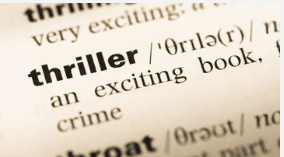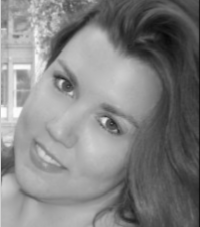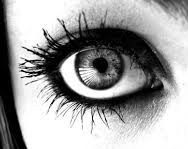Are you writing a Thriller; a story in which the protagonist is negotiating a complex world, struggling at the limits of human experience, and triumphing (usually) over seemingly overwhelming forces of antagonism? Maybe you’re confused about the difference between a Thriller story and a Crime, Action, or Horror story. Want to know if you’ve hit all the obligatory scenes and conventions of your genre?
In this article I’ll walk you through the fundamentals of the Thriller and compare and contrast it with certain aspects of Horror and Crime. In Part Two, I’ll go deeper with those comparisons and demonstrate the differing obligatory scenes and conventions of all three of these closely related genres.
First, let’s clear up some misconceptions.

Many writers confuse the Thriller Genre with the Horror or Crime Genres due to the many obligatory scenes and conventions these genres share. According to the Story Grid, the Thriller contains elements of the Horror Genre, although Robert McKee, in Story, disagrees. You might want to read the articles I wrote on Crime, Action, and Horror as a primer for this article.
What is a Thriller?
“The Thriller is an arch-plot (Hero’s Journey) external genre combining the primal genres (Action, Horror, and Crime)….The thriller…concerns the individual coping with omnipresent and often difficult to even comprehend antagonism. The external becomes internal, forcing the protagonist to make fundamental choices to unleash critical gifts..”—Shawn Coyne
The Thriller is about excitement and the need to avoid both death and damnation. While Crime stories usually end at justice or injustice, and Horror and Action stories usually end at life or death, the Thriller protagonist is pushed to their limits. Toward damnation.
So the Thriller arc is Life to Cognitive Dissonance to Death to Damnation (a fate worse than death).
A Thriller need not reach actual damnation, but the potential and the vehicle for damnation must be expressed.
What is the core emotion?
Every genre has a core emotion; the reason audiences are attracted to the type of story you’re telling.
The core emotion in the Thriller is excitement.
People choose a Thriller to experience thrills without risk. Depending on the additional internal genre, the reader is also likely to feel relief or satisfaction as the protagonist learns what is essential in time to avoid disaster.
What is the controlling idea?
A story’s controlling idea (sometimes called the theme) is the lesson you want your reader to come away with. It’s the meaning they will assign to your story, usually unconsciously. A controlling idea can be stated in a single sentence that distills the argument your story attempts to make through narrative.
It’s made up of the big value change at the climax of your story, plus the specific cause of that change.
If your Thriller is a prescriptive or positive story about what we should do, your controlling idea will be something like: Life is preserved when the protagonist unleashes his or her special gift.
If it’s a cautionary or negative story about what we shouldn’t do, your controlling idea will be something like: Death or damnation triumphs when the protagonist fails to unleash his or her special gift.
Editor Tip: Don’t worry if the controlling idea of your story is generic as well. Readers will never see this statement. The important thing is that you have a guide for your story. Controlling ideas are your compass. When in doubt about where your story should go next, review your controlling idea.
What are the obligatory scenes?
Obligatory scenes are “must-have scenes for paying off readers’ expectations as set up by the conventions of the genre.”
In any genre, if you leave out an obligatory scene for that genre, you’ll have a story that doesn’t work.
The obligatory scenes of the Thriller are:
There is an Inciting Crime indicative of a master Villain. There must be a victim and a perpetrator (even if they are the same person, as in Fight Club). The victims can be hostages, dead bodies, missing persons, or the assaulted.
There is a clear “point of no return,” the moment when the protagonist knows they can never go back to the way things used to be. There must be a precise moment when the protagonist’s world is knocked out of alignment.
The protagonist’s initial strategy to outmaneuver the antagonist fails.
Theprotagonist discovers and understands the antagonist’s external object of desire, what the antagonist wants.
The Protagonist becomes the victim. A scene reveals that the antagonist makes their crimes personal to the protagonist and the protagonist becomes the primary victim.
The core event of the Thriller, the All-is-Lost-Moment, is when the Hero is at the Mercy of the Villain in which the protagonist sees the antagonist as unbeatable and the protagonist unleashes their gift.
Editor Tip: This is a difficult scene to innovate. Compare as many Thrillers as you can to find new ways of putting the protagonist at the mercy of the antagonist.
There is a False Ending. After a scene that seems to mark the resolution, the antagonist rebounds to challenge the protagonist again.
What are the conventions?
Genre conventions are elements in the story that must be there or the reader will be confused, unsettled, or bored. Without them your story won’t work. Conventions, unlike obligatory scenes, are specific requirements for a story’s characters and/or methods of advancing plot. They can be turning points and do not necessarily have to be implemented in any certain order.
Derived from the Crime and Action Genres, all conventions in the Thriller need to support the value at stake of Justice and Injustice.
The conventions of a Thriller are:
The atmosphere is portrayed in considerable detail, becoming alive and immediately threatening.
The antagonist has an object of desire, what they want.
Editor Tip: The want must be plausible and valuable object of desire that will push the characters to obtain and fight for it. This could be nuclear codes, the cache of diamonds, money, etc. The object of desire must tie into the story logic you’ve built be a believable want of the antagonist and relate, in some way, to the protagonist’s internal genre arc (if they have one). As a story driver, the quest for the MacGuffin must create conflict, tension, and emotion.
The inciting crime must contain a clue about the villain’s object of desire.
The antagonist makes their actions personal to the protagonist: The antagonist must victimize the protagonist in order to get what they want.
Derived from the Action Genre, there is a limited time for the protagonist to act (Clock). If the protagonist doesn’t conquer the antagonist, the antagonist will get what they want by default. The clock defines the limits of the story and whether the protagonist will succeed or fail.
The protagonist actively investigates and chases clues (including false leads/red herrings) in order to find or trap the antagonist. In other words, the protagonist’s goal is to render the antagonist useless by solving a crime or a puzzle.
Editor Tip: Red herrings should be compelling enough to lead the protagonist away from the antagonist, but the protagonist must ultimately identify them as irrelevant. Red herrings are progressive complications that add tension to the story while challenging the reader’s ability to solve the puzzle ahead of the protagonist.
Lives depend on the protagonist defeating of the antagonist.
The story contains elements of suspense. Suspense is a form of narrative drive where the audience and the character know the same amount at the same time. The audience is kept in perpetual discomfort because the antagonist seems to attack randomly and never rests.
The antagonist can’t be reasoned with. They are intent on annihilation, devastation, or power at the expense of others.
There is a speech in Praise of the Villain: The cunning or brilliance of the antagonist must be praised by one or more characters or shown in a revelation.
Editor Tip: The speech in praise of the villain is an easily misunderstood convention. I like the way Story Grid Editor, Anne Hawley, clarifies it: “The speech, once the province of the evilly-laughing Bond villain praising himself, has morphed and become much more subtle in modern works.” It can be as small as a secondary character pointing out that the antagonist is far more powerful than the protagonist. Or it might be the protagonist themselves stating, during an all-is-lost moment, that they can’t beat the antagonist for a particular reason.
The protagonist is the final victim. Similar to the Horror Genre.
There is a clear threat of escalating danger, even if the danger is limited to the psyche of the protagonist, in a cause and effect chain of events.
There is at least one shapeshifter or hypocrite character capable of directly impacting the protagonist.
Editor Tip:This is a secondary character who says one thing and does another. Usually this character first appears as a helper and then becomes a hinderer, but this can be reversed. The shapeshifter’s levels of antagonism can vary greatly between characters and stories.
In a prescriptive Thriller, the antagonist must be brought to justice. In a cautionary Thriller, injustice prevails.
Editor Tip: Justice can mean death, banishment, or imprisonment. Conversely, the antagonist can get away (injustice), especially in a series, but the protagonist must be either dead or out of immediate danger with some sense of victory (win but lose, win for now).
What are the subgenres of the Thriller Genre?
Thriller subgenres are usually determined by the setting, so there can be a great deal of overlap between one subgenre and another. Don’t get bogged down with this. The more you study these subgenres and analyze their boundaries against contemporary stories, the less distinct they will seem. In time, perhaps, the subgenres will evolve or degrade and render this list antiquated. I like to think of these as plot devices rather than subgenres:
Serial Killer: Examples of this story are Red Dragon and Silence of the Lambs.
Medical: Examples of this story are Coma and The Andromeda Strain.
Legal: Examples of this story are And Justice for All, Sleepers, and Mississippi Burning.
Psychological: Examples of this story are Primal Fear, Gone Girl, and Fight Club.
Espionage: Examples of this story are The Bourne Identity, Three Days of Condor, and The Hunt for Red October.
Person in Jeopardy: Examples of this story are The Client, Ransom, and Sleeping With the Enemy.
Erotic: Examples of this story areBasic Instinct, Fatal Attraction, and Twilight.
Military: Examples of this story are Seven Days in May and The Jack Ryan Universe Series.
Political: An example of this story is Marathon Man.
Journalism: Examples of this story are The Scarecrow, The Post, andAll the President’s Men.
Financial: Examples of this story are Numbered Account, Not a Penny More, Not a Penny Less, and Black Fridays.
Hitchcock: Examples of this story are A Coffin for Dimitrios and North by Northwest.
Editor Tip: Read and watch the masterworks that use your chosen plot device and analyze them for additional conventions and tropes.
What about audience expectations of the Thriller?
Remember, you’re writing a story that incorporates aspects of the Action, Crime, and Horror Genres (and, in the case of Erotic Thriller, also includes a Love story).
A Thriller need not have much action or many horrific scenes. Don’t be afraid to slow your story down to illuminate the antagonist’s object of desire, to get sidetracked with the false clues, and to let the protagonist make some serious mistakes. Allow tension to ebb and flow. Keep your reader asking questions.
In Part Two of this article, I’ll demonstrate how the controlling ideas, global values, obligatory scenes and conventions differ between Thriller, Crime, and Horror.
Why do internal genres go well with a Thriller?
The best Thrillers have an internal genre arc for the protagonist. But they aren’t required.
Editor Tip: Not all of the obligatory scenes and conventions of the internal arc need to be met. Incorporate most of them into the scenes of the Thriller primary story rather than creating scenes stand alone scenes for the secondary genre.
For your internal genre, choose a conflict important to your characters. A character’s investment in an outcome increases investment from the reader.
If your protagonist is knowingly doing wrong, consider the Morality Genre for their internal arc.
If your protagonist is making the wrong choices or assumptions because of their immaturity, lack of knowledge, and/or naivete, consider the Worldview Genre for their internal arc.
If your protagonist is trying to fit in, gain an improvement in (or maintain) their financial, professional, or social rank, consider the Status Genre for their internal arc.
If you are writing a series, consider starting your protagonist closer to the bottom of Maslow’s Hierarchy of Needs and have them move their way up a notch in each book to keep them moving forward internally.
Determine the want and need of your antagonist. How are they related to the want and need of the protagonist? What does the antagonist really want? These wants and needs will drive your story and determine your internal genre. Create dynamic protagonist and antagonist characters with opposing goals.
Additional notes on writing the Thriller:
On characterization:
Show us how your protagonist reacts instead of telling paragraphs of their thoughts. Ground the reader in scene with scent, touch, sounds, gut reactions, and dialog. Characterization is not what the protagonist is thinking. It’s demonstrated in their actions.
Editor Tip: Having trouble with characterization and pacing? Resources worth examining are Writing with Emotion, Tension, and Conflict and The Emotional Craft of Fiction.
On moving to the next level in your writing:
Read widely in the Thriller Genre and compare your work to the masterworks and the guidelines here. The best way to move toward innovation is knowing what others have already done.
Now you have the basics of the Thriller and are primed to finish that story. When you’re ready for an editor, please contact me for a free 30-minute phone consultation on your work.
I wish you the best with your writing.
You can read more blog posts I’ve written with these links:
How to Write a Thriller, Part Two, How to Write a Performance Story, How to Write a Morality or Redemption Story, How to Write a Status Story, How to Write the Worldview (Coming of Age) Story, How to Write the Rebellion Story, How to Write a Memoir, How to Write an Action Story, How to Write a Crime Story, How to Write a Horror Story, How to Write a Western, How to Write a War Story. How to Write a Big Idea or Self-Help Book
Special thanks to Anne Hawley for editing this post.
A version of this post first appeared in the Story Grid, Fundamental Fridays blog series as Secrets of the Thriller Genre, Part One.
About the Author

Rachelle Ramirez helps writers develop their stories and believes stories are our most important catalyst for change. She received an MA in psychology from Goddard College and attended the School of the Art Institute of Chicago’s Masters in Creative Writing Program on merit scholarship. Rachelle served as the executive director for a national writing community before becoming a Certified Story Grid Editor. She is honored to have edited the award winning fiction of some amazing authors but her favorite work is with first-time novelists and memoir writers. She is easily bribed with promises of iced coffee drinks, piles of puppies, and long walks in thunderstorms. She is currently on contract, writing a Story Grid Guide to a masterwork. Her forthcoming novel is White Grrrl, Black Sheep. Grab a spot on her calendar for a free 30-minute consultation on your story.

I completely agree with what you have written. I hope this post could reach more people as this was truly an interesting post.
Thank you Paul! I’d love to share these ideas with more writers.
Thanks for sharing this great article Rachelle! Very well-written!
Cheers!
very nice and informative artical.
Thanks, Rahul. Are you writing a Thriller? Are you leaning more toward Crime, Action, or Horror?